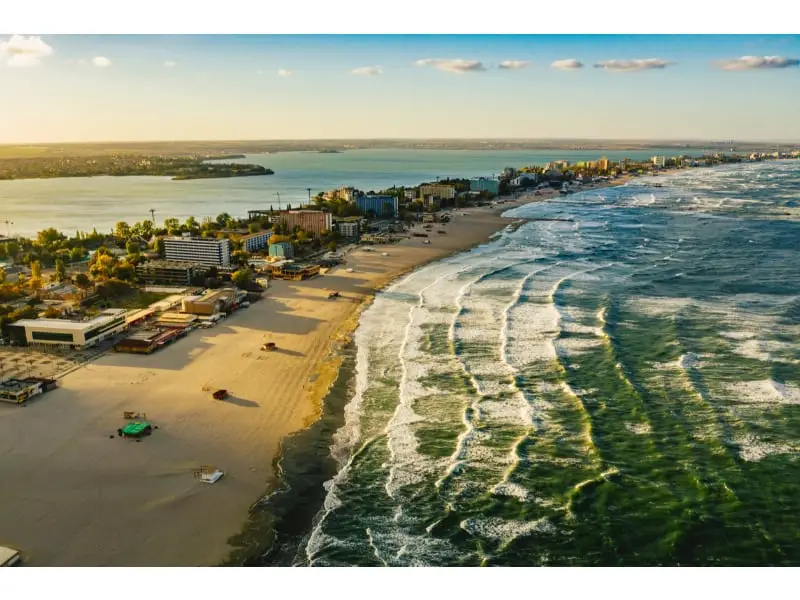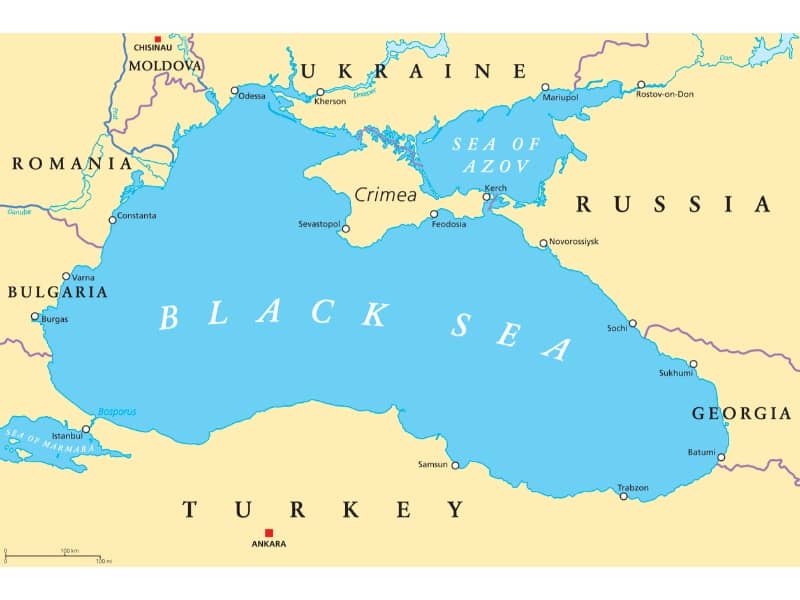Swimming in the Black Sea is doable, although it provides a more varied experience than other bodies of water. The water level in the Black Sea continually stays the same due to the lack of any low or high tides. The water level does not change because of this, so the sea remains quiet, tranquil, and calm at surface level.
You know that you can swim in the Black Sea but there is some risk involved along with the rewards, that’s why it’s my request you scroll a bit more before jumping in the black sea.
How Safe Is It To Swim In The Black Sea?

Another reason swimming is possible is that the Black Sea includes high concentrations of mineral salts, resulting in denser water than typical freshwater. This anomaly allows objects, including humans, to float on the water.
The Black Sea is a swimming paradise for children due to its low salinity. They can spend countless hours in the water without fear of eye or skin irritation.
The water is clear and gives a greenish-blue reflection in open water and a green closer to the shore due to sediment presence. The low salinity is due to the freshwater injected into the Black Sea from rainfall and numerous rivers like the Danube, Dnieper, Don, and Southern Bug.
Plenty of visitors flock to the Black Sea shorelines to enjoy the water. However, specific risks are linked to bathing in shallow waters, like any other sea. Individuals yield to the temptation to move further away from the shoreline. However, the waters become very deep a short distance from the shore.
Dangerous undercurrents also offer risks to swimmers. Pay attention to the advice and warnings of the lifeguards if the beach has any. If I tell you that not all seas are this safe for swimming, some are really toxic that you need to avoid at all costs.
Some governments issued advisories for individuals to wear proper swimming and safety gear and only frequent beaches with medical personnel or lifeguards during winding conditions.
Best Beaches On The Black Sea
Stretching across the shores of Turkey, Ukraine, Russia, Bulgaria, Romania, and Georgia, the Black Sea has activities for every type of visitor, for example, windsurfing, fishing, kayaking, parasailing, diving, and of course, swimming.

The best times to visit these beaches are between June and August, typically considered the summer months. The temperature during this period averages between 68.5 degrees Fahrenheit and 80 degrees Fahrenheit. [source]
Below are the best beaches to visit, one from each country that borders the Black Sea.
Smokinya Beach – located on the coast of Bulgaria, close to the town of Sozopol, has calm waters lined with a wide sandy beach, ideal for families.
Vityazevo Beach – along the Russian coast, is a family paradise with shallow waters and white sand. During the summer, there are activities for each member of the family. Even though this is also the busiest time of year for the beach, it is so spacious that finding a relaxing spot is no problem.
Şile – this beach’s location is on the coast of Turkey and is known as a fishing village. It offers seclusion and is very popular among the locals living in Istanbul.
Shekvetili – is a 3-mile long beach along the coast of Georgia and provides an environment of sand and pine trees, offering shade during those hot days. One attraction includes the Tsitsinatela Amusement Park, which is open to people of all ages.
Mamaia – found in Romania, is a beach full of style and luxury. In early April, the party scene begins with Sunwaves Festival. It is not a scene for those seeking tranquility, but just a stone’s throw away is the Mamaia S Camping offering luscious lawns under some shade.
Langeron Beach – located in Odessa, Ukraine, is one of the most popular and oldest beaches. Visitors to this beach can watch the dolphin show at the Dolphinarium on the shore. Your expectation when visiting this beach should be crowds and parties.
What Lies Beneath The Black Sea?
The deepest section of the Black Sea is 7,257 feet or 2,212 meters. Due to this influx of freshwater and only saltwater entering through the narrow Bosphorous straits from the Marmara and Mediterranean Seas, there are two layers to the Black Sea.
Due to the inability of the waters to mix because the saltwater is denser than the freshwater, it settles to the bottom, becoming anoxic, meaning that there is a substantial lack of oxygen.
This phenomenon means that marine life cannot survive in the lower layer of the Black Sea. However, the remains of humans, ships, and other decomposable materials such as wood, ropes, and so on, remain on the seabed long after they sunk to the bottom.
Reports are that the only thing that could survive living at the bottom of the Black Sea is sulfur bacteria.
At the surface level of the Black Sea, we find mollusks, crabs, and benthic fish. There are roughly 180 fish species such as sprat, anchovy, khamsa, white sturgeon, herring, tuna, and horse mackerel. There is also a shark known as the Spiny Dogfish, common to the Black Sea.
There are other sharks that individuals might encounter, such as the Smooth Hammerhead shark, the Longnose Spurdog, the Common Thresher, and the Small-spotted Catshark.
Dolphins also live in the waters of the Black Sea. They are the short-beaked common dolphin, the bottlenose dolphin, and the Black Sea harbor porpoise.
How Polluted Is The Black Sea?
On the shoreline of the Black Sea, you can also find decades of industrial and agricultural dumping. In 2019, scientists believed it was so bad that they reported these areas completely dead. From plastics in Bulgaria to chemicals in Ukraine, the pollution reached an alarming rate, so much so that the Ukraine government issued a no swimming advisory.
Efforts to resolve this concern started in Hungary, where one of the most polluted veins of the Black Sea, the Danube river, was being cleaned on a massive scale. [source]
The European Union provided the framework for the combination of the transfer of money and regulations for its member states to assist with improvements of the Danube river.
Scientists have discovered high concentrations of hydrogen sulfide, well known as a toxic gas, laying dormant in the depths of the Black Sea. This discovery makes the Black Sea the largest body of water containing this gas.
Other Interesting Facts About The Black Sea
The Black Sea is an inland sea due to its isolation from the rest of the world’s oceans. Scientists believe that the connection between the Black Sea and the Mediterranean and the Marmara Seas has been broken and restored a minimum of 10 times, meaning during this time, the Black Sea was both a lake and sea.
In 2014, 25-year-old Georgian swimmer Rusudan Gordeziani successfully created a new record by swimming 100km non-stop without any support freestyle across the coast of the Black Sea. She dedicated her efforts to the men and women that died in the Russian-Georgia and Abkhazian wars. [source]
In 2018, Romanian Avram Iancu swam 680km from Sulina to Istanbul for 60 days of continuous effort. His efforts broke the record for swimming the Black Sea. [source]
According to numerous scientists, the Black Sea was initially a freshwater lake, only becoming a sea close to 8,000 years ago when the Mediterranean Sea rose, introducing saltwater into the lake.
There is also a theory that the biblical story of Noah’s Ark ended its journey after the flood on Mount Ararat, located in Turkey.

Michael is heavily inclined towards traveling to natural places and documenting cultures/people from different parts of the world. He also loves hiking and camping and is spirited toward all outdoor activities. He will share his passion for outdoor life and brands or products we use outside our homes. He has good research skills, and that’s why you can see why his articles are packed with info that is factual and not readily available. He also has the vision to travel the whole world and share it with all readers of Outdoor Favor.

